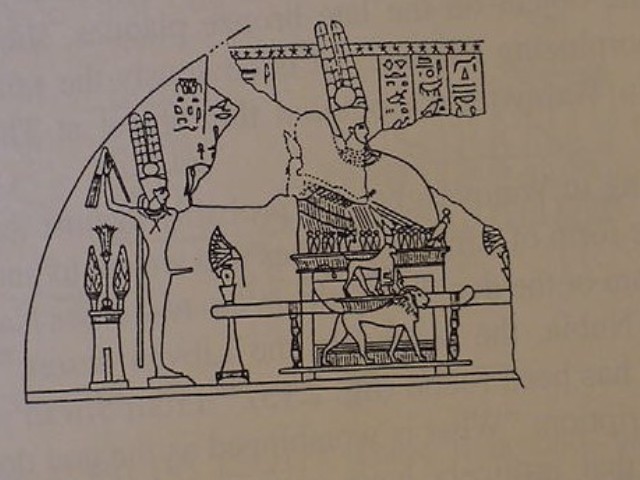Possible Egyptian Prototypes for the Ark of the Covenant
18 Feb. 2004 update
The biblical account suggests Israel served in an Egyptian bondage of 400 years before the Exodus occured. Moses, a former Prince of Egypt, supervises the building of a chest-like portable throne for the Hebrew God, Yahweh. Could Egyptian "Chest-like" portable thrones for gods be the possible prototypes behind the chest-like Ark of the Covenant (allowing for Hebrew modifications to the Egyptian design) ? They exist from Late Bronze Age times, and some scholars have suggested an Exodus in either the Late Bronze or Early Iron Age (ca. 1560-1220 BCE).
Amon-Re, King of the Gods, honored in New Kingdom times (Late Bronze Age, 1580-1220 BCE) as the god who helped Egypt conquer Syria-Palestine, in a Portable Throne, from two metal plaques ca. the 6th century BCE, with chest-like shape (like the Ark of the Covenant's chest-like shape), with a striding Sphinx (Hebrew: Cherub) on either side of the throne arms, striding Lions are below the Sphinxes. The god may be standing or sitting within the chest-like throne, it is difficult to say which. An Egyptian goddess enfolds Amon-Re within her outstretched wings. Amon-Re also appears standing as the God Min, "Lord of the East," with flail in his raised right hand. Also note a similar portable throne for Pharaohs Akhenaten who honored the ONE GOD and Ramesses III (cf. p. 52. Figures 2.10-11. Tryggve N.D. Mettinger. No Graven Image ? Israelite Aniconism in Its Ancient Near Eastern Context. [Coniectanea Biblica, Old Testament Series 42], Almqvit & Wiksell International. Stockholm, Sweden. 1995. ISBN 91-22-01664-3, pbk.)
Below is an earlier "chest-like" portable throne for an "image" of Pharaoh Amenhotep I (ca. 1551-1524 BCE). Kitchen describes it as carrying an "image" of the king to give an oracle on his festival-day (the picture is from tomb 19 at Thebes). Horus the hawk god, enfolds Pharaoh within his outstretched wings, rather riminescent of the Cherubim's wings that extend an enfold Yahweh on the Ark of the Covenant. The sphinx was called Hor-em-akhet, "Horus of the Horizon" recalling Horus as the rising Sun at morning. Pharaoh was the son of the Sun and called Horus. Please note that Pharaoh was regarded as a living god. So thrones for him are thrones for a god. Although a striding lion appears at the side of the chest-like throne there is no Winged Sphinx, as appears above in a similar chest-like throne for Amun-Re. The front of the chest-like throne may have been open or it may of had a door. It is difficult to say if the king is standing in the chest-like throne or seated within it (cf. pp. 166-167. "The Gods in Festival." K. A. Kitchen. Pharaoh Triumphant, the Life and Times of Ramesses II. 1982. Aris & Phillips Ltd. Teddington House, Warminster, Wiltshire. ISBN 0-920808-06-9. pbk.)
